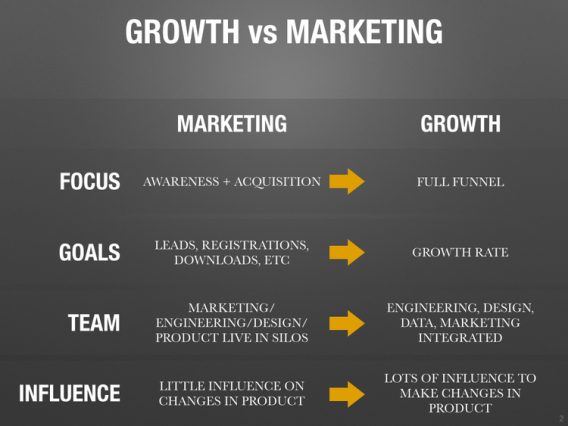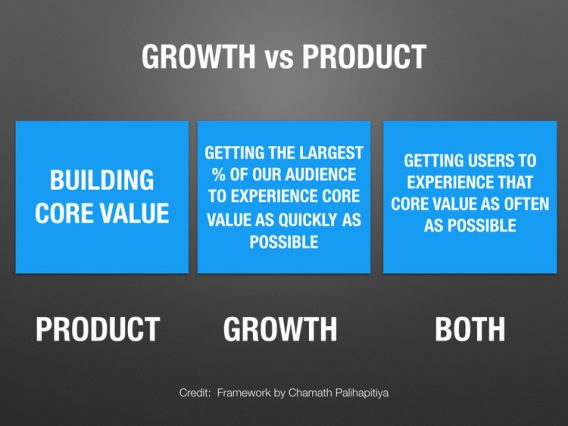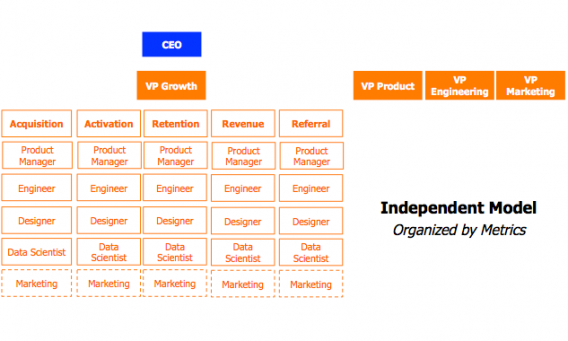As technology continues to make data-driven marketing easier to implement and control, one thing remains constant: it’s all about the effectiveness of your team.
As Paul Rouke says, we need to prioritize human intelligence in the face of increasingly sophisticated artificial intelligence, and building a high performing team is the most impactful thing you can do when it comes to growth.
There’s a degree of subjectivity to this – all companies and cultures are different – but there are some constants when it comes to building a world class growth team.
Table of contents
Quick Primer on Growth vs. Marketing
While I realize this has been written about before, it’s important to define what separates growth from marketing, because it’s largely organizational.
Some people think it’s simply a rebranding, a buzzword. In this worldview, there’s nothing fundamentally different about a growth role and a marketing role. As Ben Adelt answered on a Quora thread:

Ben Adelt:
“Nothing. Somebody along the way decided that the word “Marketing” wasn’t hip enough, so they started using phrases like “Growth Hacker” etc.
Call it whatever you like, but when businesses are hiring for any of those titles they simply want somebody who can generate lots of quality leads for as little cash as possible.”
Jonathan Price wrote on the same Quora thread that he believes growth marketing to differ from regular marketing because it “is technology-centric and it blurs the boundary between marketing and product development.”
The real difference, in my opinion at least, is that growth teams work across the boundaries set in traditional organizations and relies on rapid experimentation instead of top-down planning.
In the past, marketing teams focused primarily on the very top-of-the-funnel, measuring impressions, mind share, leads, etc. A growth team, however, is largely overlapped with product, engineering, and design as well. A growth team is made up of many different skillsets and can more easily push through ideas and experimentation that crosses traditional silos and boundaries.
In their new book, Hacking Growth, authors Sean Ellis and Morgan Brown explain that, while different company to company, the core components of growth are:
- The creation of a cross-functional team that breaks down the traditional silos of marketing and product development.
- The use of qualitative research and quantitative data analysis to gain deep insights into user behavior.
- The rapid generation and testing of ideas followed by rigorous data analysis to take action on the results
As I touched upon above, it’s also about how much of the funnel the respective teams are responsible for. A growth team tends to be full funnel focused and more integrated in their approach
According to some folks, this isn’t necessarily a new practice (though I would argue it hasn’t been cemented in a common vernacular until recently, which is important). As Gagan Biyani wrote for TheNextWeb:

Gagan Biyani:
“Furthermore, growth hacking is not a new practice, just a new term.
Anyone who figured out how to game Google’s algorithm (aka SEO) was leveraging both creativity and analytics to rapidly grow their company.
Amazon’s legendary use of A/B testing surely fits into the category of growth hacking.
So does LinkedIn’s ingenious email importing scheme (where users were prompted to let LinkedIn import their email contacts and send them a note inviting them to the service).”
This role is so misunderstood, yet also growing so quickly in popularity, that Harvard Business School conducted research around the role of “Growth Manager” (i.e. same thing as growth hacker or growth marketer):
“The Growth Manager function typically lives at the intersection of marketing and product development, and is focused on customer and user acquisition, activation, retention, and upsell.
The Growth Manager usually reports either to the CEO, the vice president of Product Management, or the vice president of Marketing. They work cross-functionally with engineering, design, analytics, product management, operations, and marketing to design and execute growth initiatives.”
Product vs. Growth?
Okay, so there’s the difference between growth and marketing. But what about between growth and product? There’s lot of overlap, but what it comes down to is metrics and goals. Here’s how Jeff Bussgang and Nadav Benbarak put it in HBR:
“Furthermore, the Growth Manager is responsible for prioritizing growth initiatives and product changes. Ideas for initiatives to create growth originate in virtually all functions in the organization.
The Growth Manager is the catcher and champion for product requests from outside the growth team. Further, the Growth Manager must implement a framework for prioritizing growth-specific product improvements, and organizing the testing rhythm.”
Brian Balfour put together a great graphic explaining the difference and overlap (inspired by Chamath Palihapitiya):
What is NOT Growth Marketing?
If this is the first article you’ve read on growth marketing, you may be disillusioned. Because according to the majority of blog posts, it’s all about the “growth hacks,” the one-off silver bullets that propel companies like Airbnb, Uber, and Facebook to massive growth:
Here’s a beautiful example of the silliness from a SEJ article:
This example is really the opposite of what growth marketing is about. It’s about team and process, not one-off hacks.
If you want to dive deeper into the growth process, check out this crazy in-depth guide we wrote on the topic.
How Growth Teams Fit Into the Organization
What goes into a good team? Well, it depends on the company and how things are set up.
There are generally two structures of growth teams in organizations:
- Product-Led Model
- Independent-Led Model
In a product-led organization (also called a “Functional Model”), the growth team will report to a product management executive and will usually be dispersed on different and specific product initiatives. This is more common in organizations that have been around longer and organizational structures are cemented in place and harder to change.
In an independent-led model, the growth team is centralized and reports to someone like a VP, Growth, who may report to a C-level executive. This structure is ideal, as it lends more power and autonomy to the growth team, but it’s hard to implement if not done early in a company’s growth.
In addition, there are different ways to build a growth team no matter the reporting and leadership structure. This usually comes down to very company specific things, like what channels are effective for growth. As such, a company with SEO as a primary growth lever tends to hire differently than a company primarily growing by virality.
Another nuance is that companies are often different in their focus or inclination. Some, like Airbnb, tend to be design-focused, where others like Lyft are more product-focused, and some are marketing-focused.
Some, like Facebook, are growth-focused and therefore pour their resources into the growth team.
This focus usually reflects the philosophy of the founders and early team members, and therefore it’s not usually something you can change. My best advice there is to join and grow in a company that reflects values similar to your own.
Building a High Performing Growth Team from Scratch
When you’re starting a growth team, who do you hire first? Who do you hire second, third, fourth? How do you scale it?
These questions, again, tend to be particular to your goals and culture. But there are also commonalities. In Hacking Growth, Sean Ellis and Morgan Brown outline common key players who make up growth teams across organizations and industries:
- Growth Lead
- Product Manager
- Software Engineer
- Marketing Specialist
- Data Analyst
- Product Designer
I’ll run through each role with a brief description as well as how they fit into a growth team.
Growth Lead
This person is the growth product owner. They may also go by other titles, like “PM, Growth,” “Growth Manager,” or “Head of Growth,” but the job is the same: lead the charge for growth in the organization.
This person sets the OKRs, the experimentation tempo, and the area of focus. They also run the all-so-important weekly growth meeting, and they monitor the performance of the program.
Sean and Morgan write that this person should be, “part manager, part product owner, and part scientist.”
Essentially, they’re the team lead and are responsible for the KPIs and metrics defined by the company.
What skills does this role entail? Quite a broad set of skills, but also some specific to the role. Sean and Morgan write in Hacking Growth:

Sean Ellis & Morgan Brown:
“All growth leads require a basic set of skills: fluency in data analysis; expertise or fluency in product management (meaning the process of developing and launching a product); and an understanding of how to design and run experiments.
Every lead must also have familiarity with the methods for growing adoption and use of the type of product or service the team is working on.”
You also need strong leadership and management skills in this role. Experiments will fail (often), and you need the skills to keep the team motivated and focused.
Seems like a daunting role, but there are tools, methods, and frameworks for managing this workload. Both Brian Balfour and Sean Ellis have done a great job writing about this process of growth program management.
We also have a certification program coming out in a few months that is aimed at preparing people for this role.
Product Manager
Because of the strong overlap with marketing and product, product managers are a key role on growth teams.
Product managers, generally, oversee the product features and how they are brought to life. As Ben Horowitz said, “A good product manager is the CEO of the product.”
Why is this role crucial to a high performing growth team? Here’s how Sean and Morgan put it in Hacking Growth:

Sean Ellis & Morgan Brown:
“In most types of company, the role is well suited to assisting in the growth hacking mission of breaking down the silos between departments and identifying good candidates in engineering and marketing to help start the growth team.
This is in large part because product managers’ experience with customer surveying and interviewing, as well as with product development, allow them to make vital contributions to the idea generation and experimentation process.
If you have this role at your company, this person should absolutely be on your growth team.”
Software Engineers
In most organizations I’ve had experience with, the limiting resource is engineering (especially in regards to growth teams). Engineers are needed to write code for product features, websites, apps, etc. and to code up experiments for the growth team in general.
Often, they’re left out of the growth process and recruited only when their skills are in need. This is largely a mistake – engineers can have some of the greatest insights and the most creative ideas, especially in regards to technical implementations and capabilities.
Another reason it’s important to have engineers housed under the growth team is that it takes a very specific mindset to be a growth engineer. They’ll be writing a lot of “throwaway” code, which many engineers aren’t particularly thrilled with
So, to have engineers with the “growth” or “experimentation” mindset on your team is a huge advantage.
Marketing Specialists
In addition to the general fast experimentation tempo and data-driven approach to marketing, growth teams operate within channel specificities. And in this arena, marketing specialists are invaluable. In addition, as Sean and Morgan write, “the cross-pollination of expertise between engineering and marketing can be particularly fruitful in generating ideas for hacks to try.”
This is also a position that will greatly differ company to company, depending what the effective channels and resources are.
If your company is content focused, you’ll probably hire marketers with content expertise. SEO-focused? Hire the best SEO specialists for your growth team.
Sean and Morgan also make a great point in Hacking Growth that you can simply bring in marketers for smaller stints focusing on an area of their expertise and then leave the growth team once the goal is achieved.
Depending on the stage of your company, you can also bring in contract or temporary channel experts to discover your marketing channels for long-term growth.
Data Analysts
You have to have guessed that in the data-driven growth process, you might want to include data analysts.
You don’t have to have an analyst as a full-time growth team member (though it helps), but you should have someone assigned to provide insights and analysis for the growth team.
This person should understand design of experiments, statistics, how to connect and draw insights from various business sources, and most importantly, how to ask good business questions and discover answers using data analytics.
Though it’s recommended that everyone on the growth team have solid grasp on analytics, having someone who is amazing at it and truly understands the craft is crucial. That means you shouldn’t skimp on resources for a good analyst. As Sean and Morgan write in Hacking Growth:

Sean Ellis & Morgan Brown:
“What is essential is that data analysis not be farmed out to the intern who knows how to use Google Analytics or to a digital agency, to cite extreme but all too frequent realities…
…Too many companies do not place enough emphasis on data analysis, and rely too heavily on prepackaged programs, such as Google Analytics, with limited capacity for combining various pools of data, such as from sales and from customer service, and limited ability to delve into that data to make discoveries.
A standout data analyst can make the difference between a growth team squandering its time and mining data gold.”
I should note that you can pull super valuable insights from Google Analytics, it just requires going beyond the out-of-the-box data like pageviews and source / medium reports. If you’re interested in that, we have a world class live course that teaches it.
Product Designers
Designers bring user-focused insights to the table and architect and design the actual experiences that we’re testing.
Just like development resources, this is another area that growth teams usually face a bottleneck. This is a bummer, because having designers on the team, or at least part of their job defined as growth, allows you to remove design bottlenecks in the experimentation workflow. Naturally, this lets you push through more ideas and experiment faster.
User experience designers can also offer increased insights in psychology as well as user research and usability research.
What Makes a Top Notch Growth Team?
So, above and beyond the simple job titles that make up a growth team, what separates a mediocre program from an excellent one? Simple hiring the above positions won’t solve all of your problems.
To find out, I asked a few growth marketers what they believe goes into the recipe.
Here’s what Willie Tran, Growth PM at Dropbox, had to say:

Willie Tran:
“A high performing growth team is excellent in these three areas:
- Raw experimentation output – The more you experiment, the more you can learn. 70% of your experiments will be losses. This number is less daunting when you have a high experimentation output.
- Experiment design – This is designing the separate treatment variants to have an outcome be as informative as possible regardless if it’s a win or not. Be thoughtful of your variants. Make V2 thoughtfully different from CONTROL and V1, so you can extrapolate more learnings.
- First principles ideation – After you pick off all the low hanging fruit, the best and most impactful ideas won’t be found in best practices. Instead, ideas should be rooted from first principles thinking. You should be asking yourself “Why would this work?” but answer the question in a non-technical terms or with a real life parallel.
An example of the last point could be: “Similar to how a gas light comes on when you’re low on gas, we should run an experiment that informs the user when they’re low on the number of seats available.”
And here’s what Sophia Eng, Senior Digital Marketing Manager, Growth & Acquisition at Workday, said:

Sophia Eng:
“A high performing growth team is always testing, always learning new tactics, and is driven by the intrinsic goal of maximizing the quality of the experience for the audience rather than capturing the number of users. Once the goal is understood, the team is set in motion.
A high performing team also regularly prioritizes the level of impact against the level of effort. We do this in our regular sprint planning sessions. A low performing growth marketer is bogged down with the numbers to try to get the numbers to grow.”
The defining traits of good growth teams seems to be similar to what makes a good conversion optimization team: rigorous process, a growth mindset, experimentation output, experiment design, and goal-based prioritization.
Conclusion
Growth is still a largely misunderstood (or unknown) function in most companies. Even past the basic distinction of what “growth” is (versus product or marketing), there’s a lot of confusion in what a growth team should actually look like.
While it varies from team to team and industry to industry, generally a growth team is made up a few key members:
- Growth Lead
- Analyst
- Marketer
- Designer
- Engineer
- Product Manager
You can customize this how you want, but the general idea is that it’s a cross-functional team.
Outside that, it appears that high performing growth teams have two things in common:
- They’re made up of high performing people
- They incorporate incredibly rigorous growth and experimentation processes.
There you have it: people and process. Not too different from what we usually preach on CXL, huh?















Amazing post! I think it is super important to have a strong team and taking the time to build them really pays off. I believe in working hard to achieve goals you set, and that is one of them. Thank you!!